The National Science Foundation has selected a proposal “Compact and robust quantum atomic sensors for timekeeping and inertial sensing” by an interdisciplinary team led by University of Wisconsin-Madison researchers for...
Read the full article at: https://engineering.wisc.edu/blog/choy-leads-team-awarded-national-science-foundation-quantum-sensing-challenge-grant/News Archives
Ke Fang, Ellen Zweibel earn Simons Foundation funding to study electrodynamics in extreme environments
Much of what we understand about fundamental physics is based on experiments done in the convenient “lab” of earth. But our planet is just one location, with its own relatively mild electromagnetic field. Do forces and energies work the same on earth as they do in all corners of the universe?
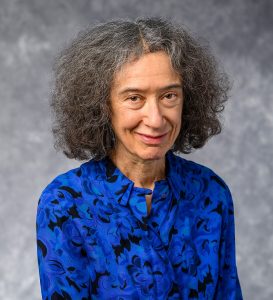
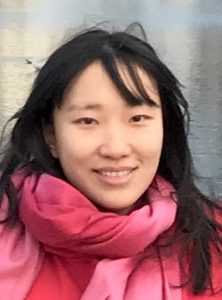
“It’s never guaranteed, as we see many theories break down at extreme environments,” says University of Wisconsin–Madison physics professor Ke Fang. “For example, a neutron star offers a magnetic field that is trillions of times stronger than on the Earth, and magnetars offer a field that is hundreds of trillions of time stronger. They are natural places to test many fundamental physics theories.”
Fang and UW–Madison astronomy and physics professor Ellen Zweibel are part of a new research collaboration announced August 21 by the Simons Foundation. The Simons Collaboration on Extreme Electrodynamics of Compact Sources (SCEECS) will study how electrodynamics — the interaction of electric currents and magnetic fields — behave in extreme environments in the distant universe using a combination of theory, simulation, and observation.
SCEECS has six main research questions, three centered on understanding electrodynamics in neutron stars and three centered in black holes. Each question pairs at least one senior-level investigator with an early-career co-investigator. Zweibel serves as the lead investigator on her black hole question, and she is paired with Richard Anantua at UT-San Antonio. Fang is co-investigator on a neutron star question, and she is paired with Anatoly Spitkovsky at Princeton.
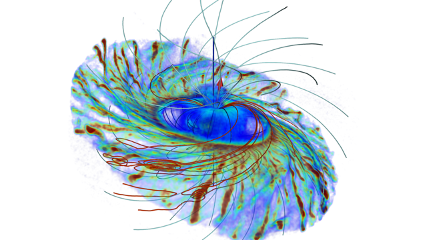
The neutron star “labs” that Fang is using are amongst the most dense stars in the universe — as small as 10 kilometers in diameter and with densities a million billion times that of water. High energy particles streaming from neutron stars are detectable on Earth, but they tend to be significantly altered by the time they make it here.
“How do those particles survive, in the sense that these extreme energy particles would interact with the surrounding media and produce secondary particles, and how do these interactions play a role in converting what you see on Earth?” Fang’s research asks. “There are also several major questions revealed by recent observations, such as extended TeV gamma-ray halos around neutron stars that are completely new phenomena. We would like to go from first principle physics to understand these phenomena.”
Zweibel’s research will use the extreme environment of spinning black holes, where the electromagnetic field has recently been identified as a major factor in accretion flows, or the movement of gases into the dense center. Her question asks how these accretion flows contribute to magnetizing black holes to form relativistic jets, or powerful emissions of radiation and high-energy particles.
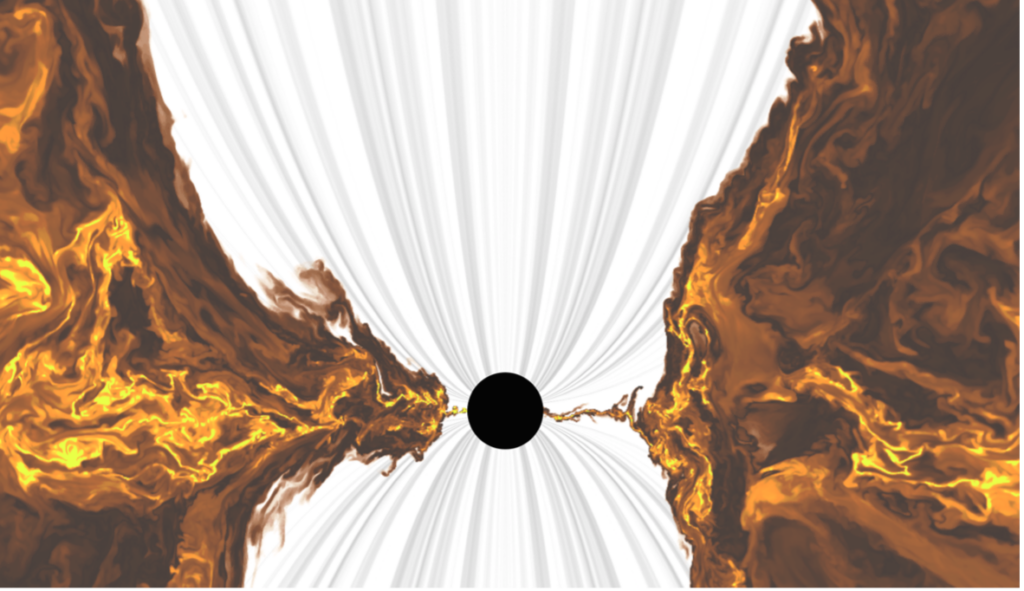
“Accretion disks, their magnetic fields, and their magnetized jets are found throughout the Universe. They play essential roles in star formation, in the evolution of double, or binary stars, and in many other astrophysical settings,” Zweibel says. “The magnetized accretion disks surrounding black holes are by far the most extreme, and test our theories to the limits. Remarkably, we can circle back to laboratory plasma experiments, including some right here at UW, to study magnetized disks and jets as well.”
SCEECS is housed at Stanford University and includes researchers from 14 other US and international universities. UW–Madison and Columbia University are the only universities that have more than one investigator in the collaboration. Most of the funding will be used to support investigators, postdoctoral fellows, and graduate students.
The collaboration plans to host an in-person kick-off in October at Stanford with regular virtual meetings throughout the year. Those meetings will be a place where everyone involved in the research, including students, postdocs, and faculty, can provide updates and seek feedback. Larger-scale collaborations such as this one are nothing new to physicists, but those groups are almost always made up of experimental physicists.
“It’s rare for theorists to be in a larger collaboration because we’re usually working alone or in a small group,” Fang says. “This program is exciting because it collects leading theorists in the field from many different institutions and provides a network for us to collaborate with each other.”
The Simons Foundation’s mission is to advance the frontiers of research in mathematics and the basic sciences. The Foundation makes grants in four areas, including Mathematics and Physical Sciences, through which this collaboration is supported.
Zain Abhari selected for SACLA graduate internship
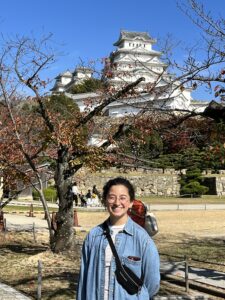
Congrats to Physics PhD student Zain Abhari for being selected to the SACLA Research Support Program for Graduate Students. The one-year internship run by SACLA (the SPring-8 Angstrom Compact free electron LAser) accepts graduate students with a demonstrated interest in using X-ray free electron lasers (XFELs) for their research and provides them with training and beam time at the facility in Japan.
Prior to her acceptance in the program, Abhari had already spent time at SACLA as part of her research in Uwe Bergmann’s group. While there, her collaborator told her about the program and recommended she apply.
“My goal after the PhD is to work at one of these large-scale facilities, specifically the X-ray free electron lasers and there’s only six of them right now in the world,” Abhari says. “If I can get my foot in the door in Japan, or get the experience to then help me with any of the other ones, that would be pretty awesome.”
Abhari was also interested in the program because SACLA’s laser aligns well with the goals of her thesis research, which is to obtain intense, stable XFEL pulses to apply to different spectroscopy techniques. For about the past decade, XFEL has allowed researchers to make ultrafast movies of molecular changes, essentially helping them to see chemical reactions take place. But x-ray lasers are “dirty,” and they contain multiple wavelengths of light of varying intensity. Last year, Bergmann and his colleagues somewhat accidentally discovered a way to make the pulses cleaner through two intense, femtosecond-spaced pulses.
Even though the researchers think they know how the useful pulses work, producing and controlling them are a completely different story — and one that Abhari hopes to unravel in her research.
“Right now, they’re just random,” Abhari says. “So the goal is to understand them. And then if we understand them, can we control them? If we can control them, can we apply them?”
Abhari will travel to Japan for three months beginning in September, where the program provides on-campus housing and time on the laser. Without the access she is now granted by this internship, her research would have been much more focused on short rounds of data collection followed by off-site data analysis.
“Now, I can get my hands on the laser and collect data to try to understand parameters that allow us to get the specific output we’re looking for,” Abhari says. “I have data that allude me to what those parameters will be, but now in real time, I can be like, ‘If I do this, I see this; if I do that, I see that.’”
In addition to her thesis research, Abhari will be working with her SACLA collaborators on a machine learning project to optimize beam focusing, and helping learn about and improve a portable beam nanofocusing apparatus.
Congrats to Prof. Joynt on his retirement!
37 years after joining the faculty of the department of physics at the University of Wisconsin–Madison, Prof. Bob Joynt has announced his retirement at the end of July.
Joynt is a condensed matter theorist who began as an assistant professor in 1986. His early work focused largely on superconductivity, including high temperature superconductors. He also played an important role in better understanding the Quantum Hall effect, dating back to his graduate work and continuing here. After a decade and a half, his career took a fortuitous turn when he wrote a quantum computing grant proposal with physics professor Mark Eriksson and other researchers in engineering.
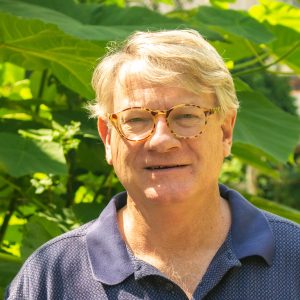
“That was really a pivotal point in my career, and I’ve been doing quantum computing mostly ever since,” Joynt recalls. “Change is good, I found. I enjoyed that change and I’m glad I did it.”
His work for the past 20 years has mainly focused on understanding the origins of noise and decoherence in quantum systems and in the design of semiconductor structures for quantum computing. Joynt is a fellow of the American Physical Society and a UW–Madison Romnes Faculty Fellow. He has co-authored over 175 peer-reviewed publications and trained 26 doctoral students, in addition to numerous postdocs and MS Physics–Quantum Computing students.
Joynt’s academic and research achievements alone comprise an illustrious career that any retiring professor would likely be happy with. Still, his contributions to the department span so much more.
Joynt served as department chair from 2011-2014, for which he focused his efforts on department fundraising. He was responsible for starting the Board of Visitors, a group of people, mostly in industry, with strong ties to the department. The BoV advises and assists on department priorities, plays a leading role in fundraising, and provides a professional network for current students and alumni. From 2017-2022, Joynt additionally served as the department’s Associate Chair for Alumni Relations and the Board of Visitors.
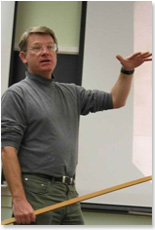
Around 2016, Joynt noted that doctoral students with quantum computing research experience were in such high demand that employers were often entering bidding wars for them. Was there a way to meet the demands of the quantum computing workforce by training students in a year or two? And so, thanks to Joynt’s vision and persistence, the MS in Physics–Quantum Computing program — the first MS in quantum computing in the U.S. — enrolled its first cohort in Fall 2019.
“We take about 25-30 PhD students each year, and now we take about the same number of MSQPC students,” Joynt says. “It’s become a big part of the department’s educational program.”
Adds Mark Eriksson, Department Chair and John Bardeen Professor of Physics: “Our department’s MSPQC program was the first in the nation and remains a model for others, thanks to Professor Joynt’s vision and energy.”
The department boasts the oldest hands-on science museum in the country — a claim we now feel confident making thanks to Joynt’s extensive research on the history of the Ingersoll Physics Museum for its 100th anniversary in 2018. The museum and physics outreach in general have always been important to Joynt. He has served in an informal capacity as faculty lead for the museum for several years now, helping to raise funds and ensure the museum fulfills its mission of providing free, hands-on, inquiry-based exhibits.
When asked what he wanted to be remembered for in the department, Joynt reflected on lessons from his career and then looked forward: “My advice to the department is: do new things. Don’t be afraid of change. Science changes, education changes, all these things are changing, and you need to change with them.”
Joynt’s retirement is official as of July 31, but he emphasizes that he is only retiring from administrative and teaching duties. He plans to continue his research efforts, sometimes in Madison and often abroad.
Mark Friesen, a senior scientist and long-time collaborator of Joynt’s, says he looks forward to continuing to work with Joynt in this new stage of his career, adding:
“When I joined the department, I knew Bob through reputation as one of the bright condensed matter physicists of his generation. I feel very fortunate to have worked with him, first as a mentor, and later as a colleague. Bob has a tremendous intuition for condensed matter that spans far beyond his immediate research efforts. He also has an easy-going and gracious style that draws in collaborators, and he is just fun to interact with, both inside and outside the department.”
Lu Lu receives 2023 IUPAP Early Career Scientist Prize
This story was originally posted by WIPAC
IceCube collaborator and UW–Madison assistant professor of physics Lu Lu received a 2023 International Union of Pure and Applied Physics (IUPAP) Early Career Scientist Prize “for her contributions to the development of high energy neutrino astronomy in the PeV energy region.” Lu accepted the award on July 27 during the opening ceremony at the 38th International Cosmic Ray Conference (ICRC) held in Nagoya, Japan.
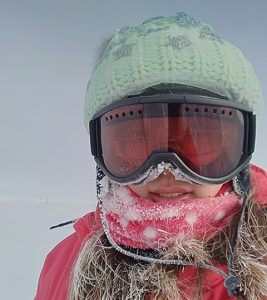
Early Career Scientist Prizes are given to early career scientists within each IUPAP commission who have up to eight years of postdoctoral research experience and have made significant contributions to the cosmic ray field. Lu is a recipient of the Early Career Scientist Prize in the Commission on Astroparticle Physics (C4).
Her PhD work focused on developing a novel technique to search for ultra-high-energy photons using data from the Pierre Auger Observatory. She also played a leading role in the initial design of the “Dual optical sensors in an Ellipsoid Glass for Gen2” (D-Egg), a two-PMT optical module for the IceCube Upgrade.
More recently, she made key contributions to the multimessenger correlation studies of the neutrino source candidate TXS0506+056 and to the detection of a particle shower associated with the hadronic decay of a resonant W boson.
Lu is currently an assistant professor of physics at the Wisconsin IceCube Particle Astrophysics Center (WIPAC) at the University of Wisconsin–Madison. Her current research focuses on diffuse high-energy astrophysical/cosmogenic neutrinos from TeV to EeV, Galactic PeVatron detection in the context of multimessenger observations, and the exploration of potential transient ultra-high-energy sources.
She is actively involved in IceCube outreach initiatives and has pioneered the development of an app that provides IceCube real-time alerts via augmented reality on mobile devices. Currently, she serves as co-lead of the diffuse science working group in IceCube and is one of three representatives of the physical science group of US-SCAR (Scientific Committee of Antarctic Research).
“I would like to express my deep appreciation for my collaborators and for those who work on foundational tasks such as reconstructions and calibrations, as their efforts behind the scenes make groundbreaking discoveries possible,” said Lu. “As early career scientists, we bear the responsibility of continuing and expanding experiments in the particle astrophysics field. We must collaborate and work together to ensure that the next generation of young scientists will have exciting discoveries to make.”
Physics researchers named part of $18M NSF materials research center
The Department of Physics is part of a six-year, $18 million grant awarded to the University of Wisconsin–Madison’s Materials Research Science and Engineering Center (MRSEC) by the National Science Foundation. The award creates a National User Facility for X-FAST (XUV Femtosecond Absorption Spectroscopy Tabletop), a powerful XUV laser developed in the department.
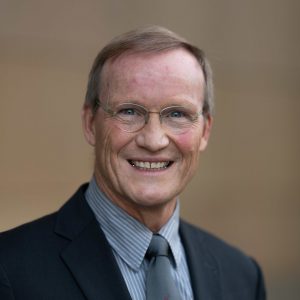
MRSEC brings together 30 affiliated faculty from across nine departments to answer fundamental questions in materials science. The two interdisciplinary research groups (IRGs) funded by the award include one on stability in supercooled glasses and a second on magnetics in strained membranes. Physics professor Uwe Bergmann is a co-lead on IRG-2 along with materials science and engineering professor and physics affiliate faculty member Jason Kawasaki.
“The idea of our IRG is to make thin membranes of materials and then by straining them in various ways, changing their properties,” Bergmann says. “And our specific role is that we are in charge of x-ray and ultrafast characterization.”
The membranes being studied are 20-50 nanometer thin, crystalline materials. Kawasaki developed a way to produce very strong strains, up to 10%, which disrupt the perfect crystal lattice when applied. Once the atoms are pulled out of equilibrium by the strain, the energy levels change a little, the bonding changes, and exotic new phases are introduced. Bergmann is part of the IRG-2 team whose role is to perform ultrafast characterization of these changes. His team then informs the simulations group, whose theoretical calculations inform Kawasaki’s sample synthesis group.
“This is the typical circle between making the sample, finding out its properties, and understanding the properties — and then feeding it back to make new samples,” Bergmann says. “We’re trying to characterize these properties so that we can tailor them, so we can control them with light.”
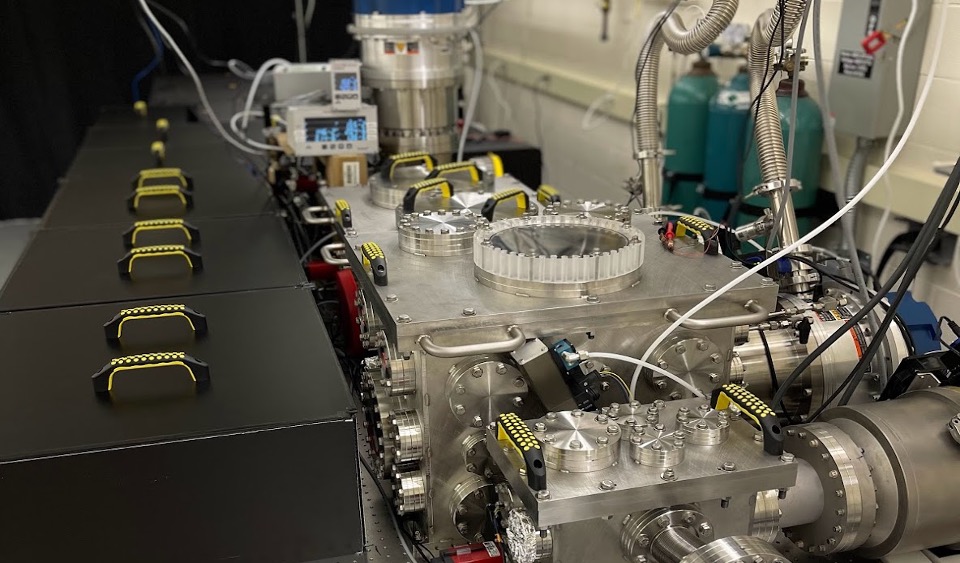
Being able to control the materials’ properties with fast, electromagnetic light pulses could be a boon to faster, more efficient computing and telecommunications, an important potential application of this work.
Bergmann’s role in MRSEC stems from his expertise in ultrafast x-ray spectroscopy. Since joining the department of physics in 2020, his group has developed and built the XUV transient absorption high harmonic generation instrument that will be used to characterize the changes in properties as a result of intense strain on the materials following ultrafast excitations. As part of the new funding, the X-FAST instrument is now a National User Facility, which provides access to researchers across the country. In addition, the new award is funding an upgrade that includes the terahertz (microwave to infrared) range for sample excitation, a range that team member and physics affiliate professor Jun Xiao has developed.
In addition to the two research thrusts, MRSEC also runs a robust outreach and education program as part of the funding.
MRSEC is one of 21 NSF-funded centers that conduct fundamental materials research, education and outreach at the nation’s leading research institutions. Paul Voyles, professor of materials science and engineering professor at UW–Madison, is MRSEC’s director.
Join us for Nite @ the Lab!
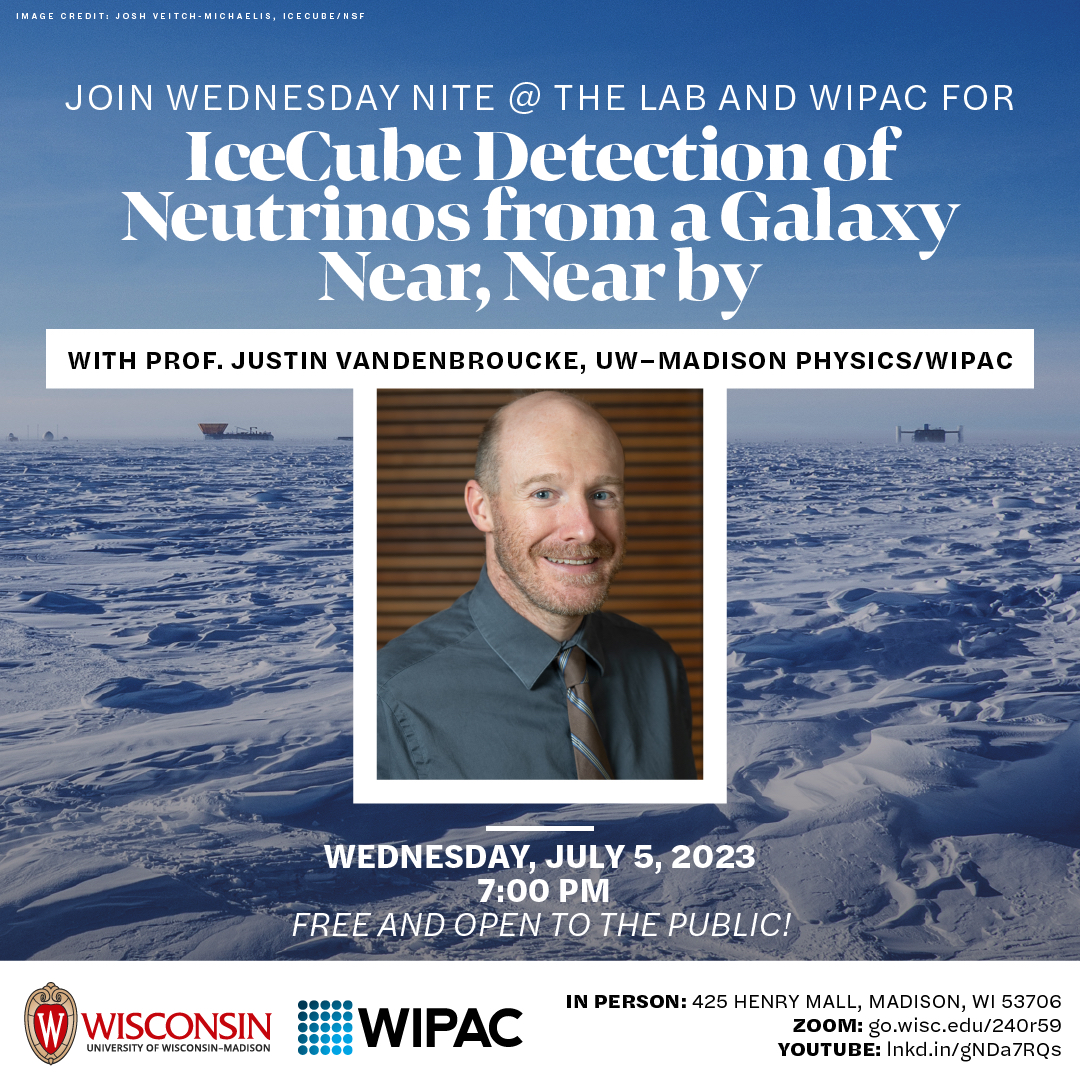
Keith Bechtol, Victor Brar promoted to Associate Professors
Congratulations to Keith Bechtol and Victor Brar, who were both promoted to associate professors of physics with tenure!
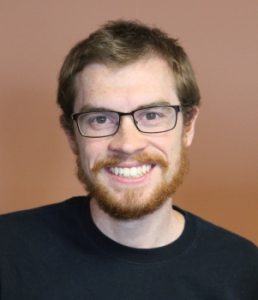
Bechtol is an observational cosmologist with research interests in dark matter and dark energy, using the whole Universe as a lab to understand the fundamental physics of nature. He is part of the Dark Energy Survey (DES) that has cataloged more 500 million galaxies and thousands of supernovae to understand the nature of dark energy. He and his group are also working on the construction and commissioning of the Vera C. Rubin Observatory in preparation for the Legacy Survey of Space and Time (LSST). LSST is expected to catalog more stars, more galaxies and more solar system objects during its first year of operations than all previous telescopes combined.
“Professor Bechtol plays a leading role in the Vera C. Rubin Observatory, which is now poised to enable a major leap in the data available for understanding the development of our universe,” says Mark Eriksson, Chair and John Bardeen Professor of Physics.
Bechtol was a co-convener of the DES’s Science Release Working Group for four years and a co-convener of the Milky Way Working Group for two years. He is now serving as Technical Coordinator for the LSST Dark Energy Science Collaboration. In 2022, he was selected to the Department of Energy’s Early Career Research Program. He also proposed and is the faculty lead for the physics department’s Thaxton Fellowship, whose goal is to provide more equitable access to physics research experiences for undergraduates.
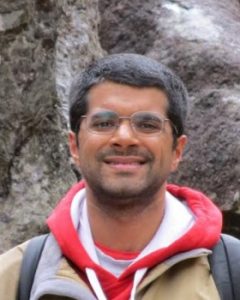
Brar, the Van Vleck professor of physics and a member of the Wisconsin Quantum Institute, is an experimental condensed matter physicist with a research focus on quantum materials and novel imaging techniques. His group works on developing metamaterials such as 2D materials for use in laser sailing or fabricating graphene structures for use in telecommunications. They also use scanning tunneling microscopy and scanning tunneling potentiometry to understand the physical and electrical properties of materials.
“The experiments performed by Professor Brar and his research team have enabled measurements of completely new regimes for electron transport in 2D materials,” Eriksson says.
Brar was awarded a Moore Inventor Fellowship in 2018, a Sloan Fellowship in 2021, and a National Science Foundation CAREER award in 2023. He has additionally received two UW–Madison Research Forward awards.
Longtime physics staff member Ed Slotten has passed away
Ed Slotten, a longtime physics department staff member who retired in 2005, passed away June 1. He was 75.
Ed joined the department shortly after graduating from Madison Area Technical College and worked here for 34 years before retiring. He was both an accountant and a research program manager.
“Ed was a friend, colleague, and superbly supported the department through the good and bad times,” says emeritus professor Don Reeder. “I was here for almost all his 34 years and witnessed his outstanding service.”
Says professor Bob Joynt: “Ed took care of me for anything financial from when I arrived in 1986 until his retirement almost 20 years later. I never had to worry about anything — he always had it covered. He was the person I also went to talk to whenever I just felt like talking — sometimes sports, sometimes university stuff — didn’t matter. He was always a source of good cheer, wisdom, and fun. RIP, Ed.”
Professor Thad Walker adds: “I was interviewing in early 1990. I knew how important efficient purchasing was going to be to getting my experiments going quickly. I kept hounding Jim Lawler for details. Jim got tired of it, took me to Ed’s office, and asked Ed to have my reimbursement check ready later that morning. Ed’s delivery of said check shut me up. Ed was an excellent, efficient, and cheerful administrator.”
Ed was also a husband and father (he is survived by his wife, Debra, his daughter, Lisa, and his son, Scott), a passionate Badger and Madison-area high school sports fan, and a U.S. Army veteran.
Ed stopped by the department somewhat regularly even after his retirement, and his visits were always welcome. He will be greatly missed.
IceCube shows Milky Way galaxy is a neutrino desert
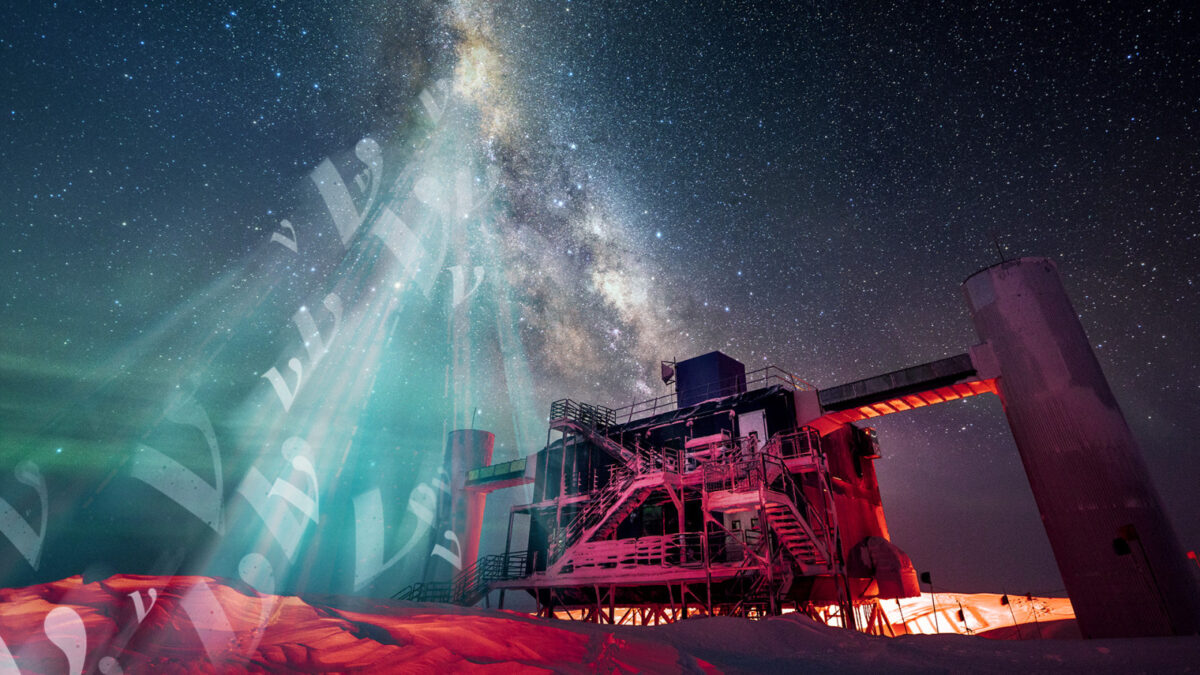
The Milky Way galaxy is an awe-inspiring feature of the night sky, dominating all wavelengths of light and viewable with the naked eye as a hazy band of stars stretching from horizon to horizon. Now,
In a June 30 article in the journal Science, the IceCube Collaboration — an international group of more than 350 scientists — presents this new evidence of high-energy neutrino emission from the Milky Way. The findings indicate that the Milky Way produces far fewer neutrinos than the average distant galaxies.
“What’s intriguing is that, unlike the case for light of any wavelength, in neutrinos, the universe outshines the nearby sources in our own galaxy,” says Francis Halzen, a professor of physics at the University of Wisconsin–Madison and principal investigator at IceCube.
The IceCube search focused on the southern sky, where the bulk of neutrino emission from the galactic plane is expected near the center of the galaxy. However, until now, a background of neutrinos and other particles produced by cosmic-ray interactions with the Earth’s atmosphere made it difficult to parse out neutrinos originating from galactic sources — a significant challenge compounded by relatively sparse neutrino production in general.